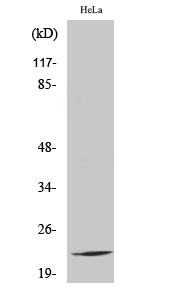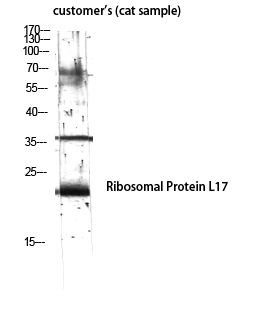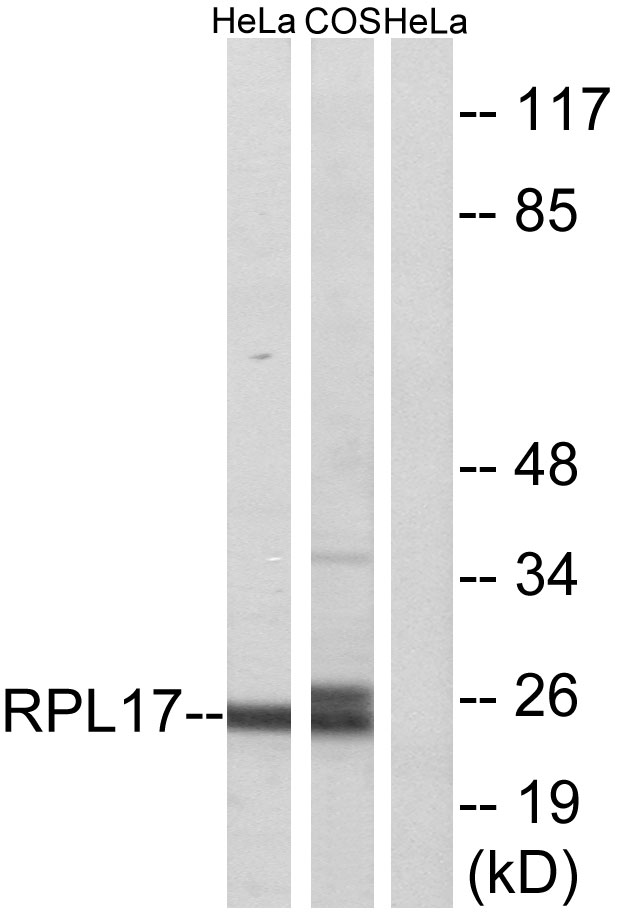Ribosomal Protein L17 Polyclonal Antibody
- Catalog No.:YT4098
- Applications:WB;IHC;IF;ELISA
- Reactivity:Human;Mouse;Rat;Monkey;Cat
- Target:
- Ribosomal Protein L17
- Fields:
- >>Ribosome;>>Coronavirus disease - COVID-19
- Gene Name:
- RPL17
- Protein Name:
- 60S ribosomal protein L17
- Human Gene Id:
- 6139
- Human Swiss Prot No:
- P18621
- Mouse Swiss Prot No:
- Q9CPR4
- Rat Gene Id:
- 291434
- Rat Swiss Prot No:
- P24049
- Immunogen:
- The antiserum was produced against synthesized peptide derived from human RPL17. AA range:101-150
- Specificity:
- Ribosomal Protein L17 Polyclonal Antibody detects endogenous levels of Ribosomal Protein L17 protein.
- Formulation:
- Liquid in PBS containing 50% glycerol, 0.5% BSA and 0.02% sodium azide.
- Source:
- Polyclonal, Rabbit,IgG
- Dilution:
- WB 1:500 - 1:2000. IHC 1:100 - 1:300. ELISA: 1:10000.. IF 1:50-200
- Purification:
- The antibody was affinity-purified from rabbit antiserum by affinity-chromatography using epitope-specific immunogen.
- Concentration:
- 1 mg/ml
- Storage Stability:
- -15°C to -25°C/1 year(Do not lower than -25°C)
- Other Name:
- RPL17;60S ribosomal protein L17;60S ribosomal protein L23;PD-1
- Observed Band(KD):
- 24kD
- Background:
- Ribosomes, the organelles that catalyze protein synthesis, consist of a small 40S subunit and a large 60S subunit. Together these subunits are composed of 4 RNA species and approximately 80 structurally distinct proteins. This gene encodes a ribosomal protein that is a component of the 60S subunit. The protein belongs to the L22P family of ribosomal proteins. It is located in the cytoplasm. This gene has been referred to as rpL23 because the encoded protein shares amino acid identity with ribosomal protein L23 from Halobacterium marismortui; however, its official symbol is RPL17. As is typical for genes encoding ribosomal proteins, there are multiple processed pseudogenes of this gene dispersed through the genome. Alternative splicing results in multiple transcript variants. Read-through transcription also exists between this gene and the neighboring downstream C18orf32 (chromosome 18 open reading f
- Function:
- similarity:Belongs to the ribosomal protein L22P family.,tissue specificity:Expressed in pancreas, lung, colon, cystic duct, gall bladder, kidney and liver. Expressed at high levels in the well differentiated pancreatic tumor cell lines HPAF, Colo 357 and Capan-1, the moderately differentiated pancreatic tumor cell lines T3M4, AsPc-1 and BxPc-3, the poorly differentiated pancreatic tumor cell line Mia Paca, and the pancreatic tumor cell lines of undefined differentiation status Panc 89 and SW 979. Expressed at lower levels in the poorly differentiated pancreatic tumor cell lines HGC 25 and Panc 1.,
- Subcellular Location:
- nucleus,cytosol,large ribosomal subunit,cytosolic large ribosomal subunit,
- Expression:
- Expressed in pancreas, lung, colon, cystic duct, gall bladder, kidney and liver. Expressed at high levels in the well differentiated pancreatic tumor cell lines HPAF, COLO 357 and Capan-1, the moderately differentiated pancreatic tumor cell lines T3M-4, AsPc-1 and BxPc-3, the poorly differentiated pancreatic tumor cell line MIA PaCa-2, and the pancreatic tumor cell lines of undefined differentiation status such as SW979. Expressed at lower levels in the poorly differentiated pancreatic tumor cell lines HCG-25 and PANC-1.
Profiling of Host Cell Response to Successive Canine Parvovirus Infection Based on Kinetic Proteomic Change Identification. Scientific Reports 2016 Jul 13 WB Cat F81 cell
- June 19-2018
- WESTERN IMMUNOBLOTTING PROTOCOL
- June 19-2018
- IMMUNOHISTOCHEMISTRY-PARAFFIN PROTOCOL
- June 19-2018
- IMMUNOFLUORESCENCE PROTOCOL
- September 08-2020
- FLOW-CYTOMEYRT-PROTOCOL
- May 20-2022
- Cell-Based ELISA│解您多样本WB检测之困扰
- July 13-2018
- CELL-BASED-ELISA-PROTOCOL-FOR-ACETYL-PROTEIN
- July 13-2018
- CELL-BASED-ELISA-PROTOCOL-FOR-PHOSPHO-PROTEIN
- July 13-2018
- Antibody-FAQs
- Products Images

- Western Blot analysis of various cells using Ribosomal Protein L17 Polyclonal Antibody diluted at 1:2000

- Western Blot analysis of customer's (cat sample) using Ribosomal Protein L17 Polyclonal Antibody diluted at 1:2000

- Immunohistochemistry analysis of paraffin-embedded human prostate carcinoma tissue, using RPL17 Antibody. The picture on the right is blocked with the synthesized peptide.

- Western blot analysis of lysates from HeLa and COS7 cells, using RPL17 Antibody. The lane on the right is blocked with the synthesized peptide.



